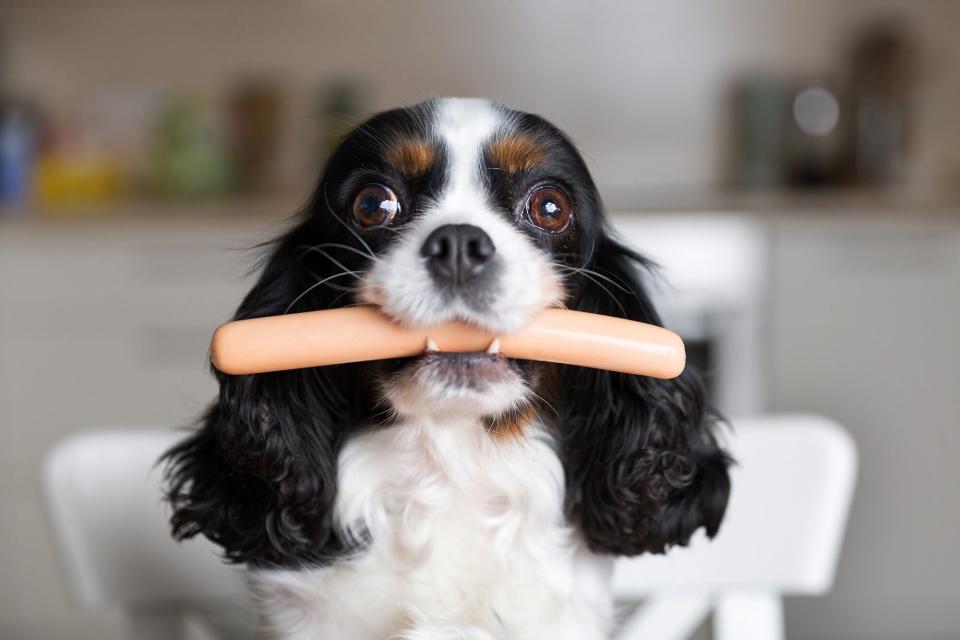Should You Use Hot Dogs as Treats?
It's a beautiful day. The sun is shining. You're cooking hot dogs on the grill out back, and your dog is looking up at you with those longing, expectant eyes, watching your every move. Spatula up. Spatula down. Turning meat. Checking meat.
Once the hot dogs have cooled off, it's cool to give the dog one, right?
It's not the end of the world, veterinarians say, but don't make it a habit. Turns out, hot dogs are safe for dogs to eat in moderation, but they're not necessarily part of a healthy, balanced diet.

fotyma / Getty
Can Dogs Eat All Types of Hot Dogs?
Unless they aggravate a dog's particular food allergy, hot dogs made out of beef, turkey, chicken or some other meat, or vegetarian hot dogs made out of cellulose or other plant-based ingredients are probably safe. With meat-based hot dogs and sausages, you should avoid feeding them raw to dogs (and that goes for you, too) to avoid bacteria.
But it's not food-borne bacteria that's the most common problem with a diet high in hot dogs. It turns out the problem is the unhealthy fat.
First, hot dogs, sausages, bratwurst, and the like can be high in fat. It's what makes them taste so good. But while hot dogs aren't toxic, per se, a lot of fat at once may cause stomach upset, diarrhea, or vomiting. High-fat diets may also play a role in heart disease and pancreatitis in dogs, says Renee Schmid, DVM, DABVT, DABT, a veterinarian toxicologist who works with Pet Poison Helpline.
So, low-fat hot dogs, and everything's cool, right? Well ... veterinarians throw around a loose benchmark that no more than 10 percent of your dog's daily calories should be treats. The rest of your dog's calories should be from a carefully balanced diet with all the vitamins and minerals (the kind that comes out of a bag, a can or from your careful home-cooked meal). Underfeeding, but more often overfeeding, can have bad consequences for your pet.
It's basic math: A whole hot dog might be around 150 calories (check the label). Depending on the dog's size, total calories could be 200 to 1,300 calories a day, according to one estimate at the Association for Pet Obesity Prevention (APOP). That means only 20 to 130 calories each day can come from treats. A healthy, large 90-pound dog might be able to chew up and eat an entire hot dog in a few seconds, but that hot dog would equal all the treat calories that she would get all day.
It's even worse for small dogs: A 20-pound dog gobbling up a 150-calorie hot dog is eating more than one-third of her daily calories and almost four times the amount of treat calories for the day!
RELATED: Obesity in Dogs: Why a Paunch is Bad for Your Pooch
Should You Use Hot Dogs as Training Treats?
Because they taste so good, pieces of hot dogs are sometimes used as a high-value treat to reward dogs in behavior training. They're also a handy way to hide a pill so your dog will take it.
Lori Prantil, MPS, DVM, who counsels pet owners on nutrition at VCA South Shore Weymouth, says leaner meat options, like small pieces of plain cooked chicken breast, might still motivate a dog in training and fit in easier in a balanced diet.
If you use hot dog pieces to hide pills, use the smallest piece you can to hide the medicine, recommends Ernie Ward, DVM, CVFT, a veterinarian and founder of APOP.
"Your dog just likes the taste and the aroma of the hot dog," Ward says. "You don't need to give the whole hot dog."
Are you ready to level up in dog treat savvy? There are a couple of ways and one might appeal more to your individual dog than the other.
1. Know your dog's calories.
Figure out how much food you really feed your dog (check the serving and the actual cup and bowl sizes you're measuring). "A bowl of dog food" doesn't mean much if you're not comparing to the serving amount listed on the bag or can. And every dog is different; some are more active than others. If you don't really know if you're feeding too much or too little, ask your veterinarian for some guidance.
2. Switch to less calorie-dense treats.
Think about substituting healthier treats for high-fat, higher-calorie foods like hot dogs. Hey, fruits are sweet, and many vegetables have a satisfying crunch: "I love zucchini and celery stalks and carrots and cucumbers, those crunchy things," Ward says. "Dogs sometimes seem to prefer textures that crunch and crackle."
Remember, rules aside, if you love giving treats to your dog, you don't have to stop entirely. Sharing food and eating with your dog is fun and emotionally rewarding. Just make those daily treats count by cutting down on portion sizes of high-calorie choices and focusing on another wonderful long-term goal: Giving your dog the right nutrients in the right amounts to be your strongest, healthiest, best buddy for many years to come.

